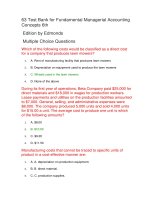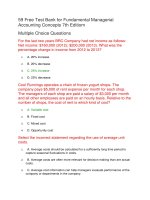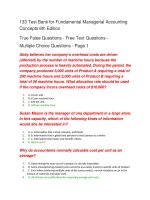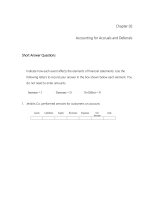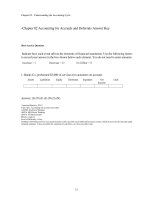Solution manual for fundamental managerial accounting concepts 5th edition edmonds
Bạn đang xem bản rút gọn của tài liệu. Xem và tải ngay bản đầy đủ của tài liệu tại đây (3.87 MB, 68 trang )
Full file at />
Answers to Questions
1.
Financial accounting deals with regulated, historical, financial
information that pertains to the whole company and is designed
primarily to meet the information needs of outsiders. Managerial
accounting is concerned with unregulated financial, economic
as well as physical data, which pertains more to the sub-units of
the organization, that is current and future oriented, and that is
designed primarily to meet the information needs of insiders.
2.
The value-added principle means that management accountants
are free to engage in any information gathering and reporting
activity so long as the activity adds value in excess of its cost.
Estimates of future product costs are permissible in managerial
accounting reports for budgeting and product costing but would
not be allowed by financial regulations in financial accounting.
3.
The two dimensions of the TQM program are: (1) management
should follow a continuous, systematic problem solving
philosophy that engages all employees to eliminate waste and
errors and to simplify the design and delivery of products and
services to customers, and (2) organizations need a strong
commitment to customer satisfaction. TQM is being used in
business to maintain profitability in an increasingly competitive
global market. In this environment, profit margins are tight, and
therefore, inefficiencies can more easily erode business profits.
To eliminate waste, errors, and dissatisfied customers,
information must be timely and relevant in order to prevent or
discover and correct mistakes immediately.
buy this full document at
Full file at />
4.
Both financial and managerial accountants need cost
information about the company’s products and services. In
managerial accounting cost information is useful in product
pricing decisions and is an essential part of cost control
(comparing actual product cost to budgeted product cost to
assess needed improvement) and performance evaluation
(assess managers’ success in controlling and eliminating
unnecessary cost).
In financial accounting cost information
about the product is needed to determine ending inventory on
the balance sheet and cost of goods sold on the income
statement. Product costing in financial accounting can impact
the decisions of not only managers but also outsiders such as
investors, creditors, and taxing authorities. Product costing
information in managerial accounting can affect the product’s
price as well as management’s decisions as to whether cost
correction changes are needed.
5.
A cost that has the future economic potential to increase assets
is recorded as an asset (e.g. cost of products purchased). A cost
that is used in the process of earning revenue is recorded as an
expense (e.g. administrative salaries, and product cost for
products sold).
6.
The cash paid to production workers has not been used to
produce revenue but to produce inventory. The revenue is
earned when the inventory is sold at which time the cost of
salaries associated with those products sold should be
expensed.
7.
Product costs associated with goods that have not been sold are
recorded in the account called inventory. Inventory cost is
shown on the balance sheet as an asset. The amount of total
assets and net income will be higher if a product cost is
classified as an asset than if it is expensed. Product cost
associated with goods that have been sold should be recorded in
the account called cost of goods sold. Cost of goods sold is an
expense shown on the income statement. The amount of total
assets and net income will be lower if a product cost is classified
as an expense as opposed to being classified as an asset.
buy this full document at
Full file at />
8.
An indirect product cost cannot be easily or economically traced
to a specific product. Product costs that would be considered
indirect include costs such as production supplies, salaries of
production supervisors, and depreciation, rent, and utilities on
factory facilities.
9.
Product costs are all costs incurred to obtain a product or
provide a service. These costs are treated as assets, recorded in
inventory, and expensed when the associated products are sold.
Period costs are all costs not associated with a product. They
are associated with the general, selling, and administrative
functions of the business and most are expensed in the period in
which the associated economic sacrifice is made. A product cost
would be the cost of direct materials used in the production of a
product. A period cost would be rent on administrative facilities.
10.
The effects of cost classification on the financial statements can
have important implications with respect to the following:
(1)
The availability of financing - Investors and creditors use
financial statement data to predict businesses’ future
earnings. Favorable financial statements provide evidence
of favorable future performance whereas unfavorable
financial statements are an indication of possible poor
future financial performance. A company with favorable
financial performance is more likely to generate sufficient
cash flows to make interest payments, to repay the
principal balance of its liabilities, and to pay dividends.
Hence, investors and creditors believe they have a greater
probability of receiving interest payments, the return of
principal, and return on investment when companies show
favorable financial statements. Since expenses reduce
profit and financial performance, classifying a cost as an
expense will inhibit the company’s ability to obtain
financing. Classifying a cost as an asset, which will
increase profit, total assets, and equity, enhances
businesses’ ability to obtain financing.
buy this full document at
Full file at />
10. (Continued)
(2)
(3)
Management motivation - Executive compensation may be
affected by financial statement data. Many managers’
bonuses are based on a percentage of net income. If costs
are classified as expenses, net income will be reduced
which in turn affects managerial income. Managers may
even be tempted to misclassify costs in order to manipulate
financial statement data to their advantage.
Income tax considerations - With respect to taxes,
managers prefer to classify costs as expenses rather than
assets. Classifying a cost as an expense reduces net
income and in turn reduces income taxes, which are
determined by computing a designated percentage of
taxable income.
11.
Cost allocation is the process of dividing a total cost into parts
and assigning the parts to relevant objects. The determination
of interest expense on a note payable is an allocation. If the note
pays $1,200 of interest a year and has been outstanding for 3
months, then 3/12 or $300 of the $1,200 total interest expense
should be allocated to interest expense for the three-month
period. The remaining 9/12 of interest would be allocated to
interest expense for the remaining 9 months of the year.
12.
In recognition of its responsibility to uphold high ethical
standards of conduct, the Institute of Management Accountants
issued a Statement of Ethical Professional Conduct.
The
statement sets forth professional ethical standards covering the
areas of competence, confidentiality, integrity, and objectivity
that management accountants are required to abide by in order
to maintain their professional and personal integrity.
13.
Some of the more common ethical conflicts encountered by
accountants include the following:
buy this full document at
Full file at />
(1)
(2)
(3)
(4)
Pressure to perform duties for which they are not
competently trained.
Pressure to disclose confidential information.
Pressure to engage in falsification, embezzlement, and
bribery.
Pressure to issue misleading or incomplete reports.
14.
A pricing decision must include all costs associated with the
product.
The manufacturing product cost as well as all
upstream costs (costs that occur before the manufacturing
process begins, e.g., research and development costs) and
downstream costs (costs that are incurred after the
manufacturing process, e.g., sales commissions) must be
covered by the product’s revenues in order for the company to
be profitable.
15.
JIT inventory system is a reengineering principle where
inventory is made available for customer consumption at the
time of customer demand. A JIT inventory system is designed to
eliminate the storage of large amounts of inventory.
By
eliminating the storage of inventory, costs related to inventory
such as financing, warehouse space, security and maintenance,
theft, damage and obsolescence can be reduced or eliminated.
16.
Reengineering is the term used to explain companies’ responses
to world-wide competition by changing production and delivery
systems so as to eliminate waste, reduce errors, and minimize
costs.
Some of the best practices used by world-class
competitors include activity-based management, value-added
activities, and just-in-time inventory acquisition.
17.
In traditional costing systems, indirect costs are assigned to
products, services, or customers using some allocation base
measured in volume such as direct labor hours. In activitybased costing a different allocation system is used to improve
the accuracy of allocations. With activity-based costing, indirect
costs are first assigned to organizational activities and then to
buy this full document at
Full file at />
products, services, or customers based on their use of that
activity. There is usually a two-level allocation process and more
than one allocation base may be used.
18.
A value chain is the sequence of activities through which an
organization provides products to its customers.
19.
A value-added activity is any unit of work that contributes to a
product’s ability to satisfy customer needs.
Value-added
activities include the following:
(1) Input activities - research and development, product
design, and hiring and training.
(2) Processing activities - assembly, inspection, and storing.
(3) Output activities - marketing, distribution, and customer
relations.
(4) Administrative activities - accounting and legal services,
personnel management, and public relations.
Nonvalue-added activities are tasks undertaken that do not
contribute to a product’s ability to satisfy customer needs.
Examples would include the following:
(1)
(2)
(3)
Maintaining excess quantities of inventories.
Transporting materials and products.
Machine set-ups.
buy this full document at
Full file at />
Exercise 1-1A
a.
b.
c.
d.
e.
f.
g.
h.
i.
j.
Managerial Accounting Financial Accounting
X
X
X
X
X
X
X
X
X
X
Exercise 1-2A
Product Cost
a.
b.
c.
d.
e.
f.
g.
h.
i.
j.
General, Selling, and
Administrative Cost
X
X
X
X
X
X
X
X
X
X
Exercise 1-3A
buy this full document at
Full file at />
Cost Category
Production supplies
Depreciation on administration building
Depreciation on manufacturing equipment
Research and development costs
Cost to set up manufacturing equipment
Utilities used in factory
Cars for sales staff
Distributions to stockholders
General office supplies
Raw materials used in the manufacturing process
Costs to rent office equipment
Wages of production workers
Advertising costs
Promotion costs
Product /
G,S,&A
Product
G,S,&A
Product
G,S,&A
Product
Product
G,S,&A
Neither
G,S,&A
Product
G,S,&A
Product
G,S,&A
G,S,&A
Asset /
Expense
Asset
Expense
Asset
Expense
Asset
Asset
Asset
Neither
Asset
Asset
Expense
Asset
Expense
Expense
Exercise 1-4A
Assets
NA
+
Liab.
+
+
Equity
–
NA
Rev.
NA
NA
Exp.
+
NA
Net Inc.
–
NA
Exercise 1-5A
Assets
= Equity
Income Statement
Event
Manuf. Office Com. Ret.
No. Cash + Inventory + Equip. + Furn. = Stk. + Ear. Rev. – Exp. = Net Inc.
1.
NA
NA
NA
D
NA
D
NA
I
D
2.
NA
I
D
NA
NA
NA NA
NA
NA
buy this full document at
Full file at />
Exercise 1-6A
a.
The three main components of product cost for a
manufacturing entity are direct materials, direct labor, and
manufacturing overhead.
b.
The product cost in a merchandising company, such as a
retail toy store, is relatively easy to determine. It includes
vendor’s price charged on the invoice, freight cost, and other
necessary costs to make the inventory available for sale.
Measuring product cost for a manufacturing entity, though,
requires a more complex system.
First of all, the
manufacturing firm has to classify its costs between product
costs and period costs. The firm has to accumulate product
costs such as direct materials, direct labor, and
manufacturing overhead. Once the product costs have been
accumulated, the firm has to classify the cost of a product
that has been sold as expense, and the cost of an unsold
product as inventory, an asset.
c.
If each product is given a fixed amount of space for display, it
is possible to use the percentage of space occupied by each
product to allocate the rental cost. However, the cost of
measuring the square footage occupied by each product may
be so high that it outweighs the benefit of generating more
accurate information.
The wages paid to workers who restock the shelves regularly
cannot be allocated to individual products easily because the
number of products handled by workers is huge and the time
spent on each product often fluctuates according to changing
market conditions.
The salary of the store manager cannot be allocated to
individual products easily, either. The manager oversees the
overall store operation including product stocking decisions,
hiring, and pricing.
Exercise 1-7A
buy this full document at
Full file at />
a.
Payroll costs that would be classified as general, selling, and
administrative expense include the following:
Salary of the company president
Salary of the chief financial officer
Salary of the vice president of marketing
Salaries of administrative secretaries
Commissions paid to sales staff
Total
b.
$100,000
40,000
25,000
81,000
126,000
$372,000
Payroll costs that would be classified as product cost include
the following:
Salary of the vice president of manufacturing
Salary of middle managers in manufacturing plant
Wages of production workers
Salaries of engineers and maintenance crew
Total
$
40,000
120,000
3,940,000
125,000
$4,225,000
Since 4,000 units of 5,000 finished products were sold, 80%
(i.e. 4,000 ÷ 5,000) of the product cost would be classified as
cost of goods sold. Therefore, the payroll cost that would be
included in cost of goods sold is determined as follows:
$4,225,000 x 80% = $3,380,000
Exercise 1-8A
Event
Assets
Manuf.
=
Office
Equity
Com. Ret.
Income Statement
buy this full document at
Full file at />No. Cash + Inventory + Equip. + Furn. = Stk. + Ear. Rev. – Exp. = Net Inc.
1.
NA +
I
+
D
+ NA = NA + NA NA – NA = NA
2.
NA +
NA
+ NA + D
= NA + D
NA – I =
D
3.
I +
NA
+ NA + NA = NA + I
I – NA =
I
4.
NA +
D
+ NA + NA = NA + D
NA – I =
D
5.
I +
NA
+ NA + NA =
I + NA NA – NA = NA
6.
D +
I
+ NA + NA = NA + NA NA – NA = NA
7.
D +
I
+ NA + NA = NA + NA NA – NA = NA
8.
D +
NA
+ NA + NA = NA + D
NA – I =
D
Exercise 1-9A
a.
Raw materials purchased and used
Wages of production workers
Depreciation on manufacturing equipment
Total product cost
$ 6,300
7,060
8,740
$22,100
b.
Cost of inventory per unit = $22,100 ÷ 3,400 = $6.50
Ending inventory in units = 3,400 – 2,040 = 1,360
Cost of ending inventory = $6.50 x 1,360 = $8,840
c.
Cost of goods sold = $6.50 x 2,040 = $13,260
Exercise 1-10A
a.
Event No. 1 represents the depreciation on the computers
because no product inventory exists in a service organization.
The cost of depreciation, thus, must be expensed.
buy this full document at
Full file at />
b.
The computers in a service organization must be expensed as
explained in Part a. This transaction decreases the asset
equipment and retained earnings, both balance sheet accounts.
The transaction increases expense on the income statement.
The depreciation on production equipment in a manufacturing
company decreases the equipment account and increases the
inventory account. It does not affect the income statement until
the product is completed and sold.
Exercise 1-11A
Event No.
1. Adjusting entry
2. Adjusting entry
3. Adjusting entry
4. Adjusting entry
5. Adjusting entry
6. Adjusting entry
Net Income
Amount of
Change
($1,500)
NA
($4,000)
NA
($800)
NA
buy this full document at
Full file at />
Exercise 1-12A
a.
The $8,000,000 of research and development cost is an upstream
cost while packaging, shipping, and sales commissions are
downstream costs.
b.
Cost of goods sold: $22 x 18,000 = $396,000
Ending inventory: $22 x 3,000 = $66,000
c.
Upstream cost per unit, $8,000,000 ÷ 200,000
Manufacturing cost per unit
Downstream cost per unit
Total cost
Plus: 25% profit margin, $70 x 25%
Sales price
$ 40.00
22.00
8.00
70.00
17.50
$87.50
d.
Income Statement
Sales Revenue ($87.50 x 18,000)
Cost of Goods Sold
Gross Margin
Research and Development
Selling Expenses ($8 x 18,000)
Net Income (Loss)
e.
$ 1,575,000
(396,000)
1,179,000
(8,000,000)
(144,000)
$ (6,965,000)
The upstream cost of research and development is required by
GAAP to be expensed in the period that it is incurred. However,
the R&D is expected to result in overall sales of 200,000 units.
The income statement for 2009 includes the sales of only 18,000
units while recognizing the entire cost of R&D as expense. In
other words, the net loss is only temporary and a result of timing
differences.
Exercise 1-13A
If Veazey has effectively implemented a 100% just-in-time
inventory system, the company can sell products without
maintaining any inventory on hand. This is true if Veazey
instructs its suppliers to ship products directly to Veazey’s
customers when Veazey receives customer orders.
Exercise 1-14A
buy this full document at
Full file at />
a.
Income Statement
Sales Revenue ($6 x 725)
Cost of Goods Sold ($5 x 725)
Gross Margin
Waste Due to Excess Inventory ($5 x 75)
Net Income
$ 4,350
(3,625)
725
(375)
$ 350
Income Statement
Sales Revenue ($6 x 800)
Cost of Goods Sold ($5 x 800)
Net Income
$ 4,800
(4,000)
$ 800
b.
The opportunity cost of lost profit: ($6 – $5) x 25 = $25
c.
If Ms. Kent can arrange an effective JIT system, the T-shirts
would be delivered by the supplier just in time for customers to
purchase. To give an example of such a system, assume that the
supplier sets up a simple T-shirt printing facility at Tingle School.
The supplier could bring in enough generic T-shirts. When a
customer wants to buy a T-shirt from Julie Kent, the supplier
could print the school’s special art design on a generic T-shirt
and deliver the T-shirt to Ms. Kent. In this JIT design, Ms. Kent
would not have to carry any inventory. The supplier would keep
only generic product as inventory, which could be sold in other
events.
If an effective JIT system is implemented, Ms. Kent would not
have to keep any inventory, and thus, would avoid the loss due
to excessive inventory. Ms. Kent would be able to meet all
customer demand because the supplier could deliver whatever
quantity of product that Ms. Kent's customers demand.
Therefore, Ms. Kent could avoid the opportunity cost due to lost
sales.
Exercise 1-15A
a.
The new inventory system is an approximate just-in-time system
since it does not eliminate all inventory.
buy this full document at
Full file at />
b.
Reduced cost of inventory: $42,000 – $8,000 = $34,000
Finance cost: $34,000 x 9% = $3,060
Total eliminated inventory holding cost: $5,000 + $3,060 = $8,060
Exercise 1-16A
a.
While the entire $54,000,000 of transportation cost should have
been expensed immediately, the CFO put the $54,000,000 into an
inventory account. Since some of the inventory was not sold,
some of the transportation cost is still in the inventory account.
The computations are shown below:
$54,000,000
Misclassified cost per unit = ––––––––– = $4,500 per microscope
12,000
Number of units in ending inventory:
Inventory Completed
Less Inventory Sold
Ending Inventory
12,000
(7,000)
5,000
The portion of transportation cost still in ending inventory is
$22,500,000 ($4,500 x 5,000 units).
Instead of being in the inventory account, the $22,500,000 should have
been expensed. As a result, assets, retained earnings, and net income
are overstated by $22,500,000. Expenses are understated by the same
amount.
b.
The maximum penalty for an intentional misrepresentation is
punishable by a fine of up to $5 million and imprisonment of up to
20 years.
Exercise 1-17A
The CFO and controller violated the Statement of Ethical Professional
Practice on two major items: integrity and objectivity. Regarding
integrity, the officers’ personal interests conflicted with the public
interest because the officers reaped a bonus that they didn’t deserve.
Moreover, their actions certainly discredited the accounting
buy this full document at
Full file at />
profession. Regarding objectivity, the officers didn’t communicate
information fairly and objectively.
Exercise 1-18A
The process of shipping the encased speakers back to SoundWave
Company by Herrin Cabinet, Inc. is nonvalue-added. This process
can be eliminated if Herrin ships the product to SoundWave’s
customers directly.
buy this full document at
Full file at />
Problem 1-19A
The following horizontal financial statements model is not required in the problem. It is provided to show
the process of computation.
Event
No.
1.
2a.
2b.
3a.
3b.
4.
5.
6.
7a.
7b.
Total
Cash
Assets
Office
+ Invent. + Furn.*
85,000 +
(10,000) +
+
(54,000) +
+
(11,000) +
(16,000) +
(16,000) +
90,000 +
+
68,000 +
+
+ 10,000
+ (2,000)
+
10,000 +
+
16,000 +
16,000 +
+
(36,000) +
6,000 +
8,000
=
Equity
Manuf.
Common
+ Equip*. = Stock + Ret. Ear.
+
+
+
+ 54,000
+ (10,000)
+
+
+
+
+
+ 44,000
= 85,000
=
=
=
=
=
=
=
=
=
= 85,000
+
+
+ (2,000)
+
+
+ (11,000)
+
+
+ 90,000
+ (36,000)
+ 41,000
Income Statement
Rev.
90,000
90,000
*Record accumulated depreciation as negative amounts under these columns.
buy this full document at
–
–
–
–
–
–
–
–
–
–
–
–
Exp.
2,000
11,000
36,000
49,000
=
Net Inc.
=
=
=
(2,000)
=
=
= (11,000)
=
=
= 90,000
= (36,000)
= 41,000
Full file at />
Problem 1-19A (continued)
a.
Direct materials
Direct labor
Manufacturing overhead
Total product cost
Divided by
Average cost per unit
$16,000
16,000
10,000*
42,000
÷ 7,000
$6.00
* Depreciation of manufacturing equipment:
($54,000 − $4,000) ÷ 5 = $10,000
b.
Cost of goods sold:
$6 x 6,000 = $36,000
c.
Ending inventory:
$6 x (7,000 − 6,000) = $6,000
d.
$41,000
e.
$41,000
f.
$68,000 + $6,000 + $8,000 + $44,000 = $126,000
buy this full document at
Full file at />
Problem 1-20A
Event
No.
1.
2.
3.
4.
5a.
5b.
6a.
6b.
7a.
7b.
Total
Cash
70,000
(9,500)
(5,400)
(6,400)
(11,900)
(38,000)
40,000
38,800
Assets
Manuf.
+ Invent. + Equip.*
+
+
+ 9,500 +
+
+
+ 6,400 +
+
+
+
+
+
+ 38,000
+ 9,000 + (9,000)
+
+
+ (20,000) +
+ 4,900 + 29,000
=
Office
+ Furn.* =
+
=
+
=
+
=
+
=
+ 11,900 =
+ (2,100) =
+
=
+
=
+
=
+
=
+ 9,800 =
Equity
Income Statement
Common
Stock + Ret. Ear. Rev. – Exp. = Net Inc.
70,000 +
–
=
+
–
=
+ (5,400)
– 5,400 = (5,400)
+
–
=
+
–
=
+ (2,100)
– 2,100 = (2,100)
+
–
=
+
–
=
+ 40,000 40,000 –
= 40,000
+ (20,000)
– 20,000 = (20,000)
70,000 + 12,500 40,000 – 27,500 = 12,500
*Record accumulated depreciation as negative amounts under these columns.
Problem 1-21A
buy this full document at
Full file at />Lepper Company
Income Statement for 2009
Balance Sheet as of 12/31/2009
Sales revenue
$2,400
Assets
1
Cost of goods sold
(2,040)
Cash3
$1,376
1
Gross margin
360
Fin. goods inventory
1,020
2
Administrative expense
(324)
Total assets
$2,396
Net income
$
36
Equity
Common stock
Retained earnings
Total equity
$2,360
36
$2,396
1
The product costs include $720 for materials, $1,800 for labor, and $540 for overhead. Accordingly,
$3,060 (i.e., $720 + $1,800 + $540) was used to make the 300 units of product. The cost per unit is
$10.20 (i.e. $3,060 ÷ 300 units). Since 200 units were sold, ending inventory will be composed of 100
units (i.e. 300 units – 200 units). The amount of cost of goods sold is $2,040 (i.e., $10.20 x 200 units).
The balance in ending inventory would be $1,020 (i.e., $10.20 x 100 units).
2
Administrative expenses are composed of $180 administrative salaries + $144 administrative rent =
$324.
3
Cash balance: $2,360 -– $720 – $1,800 – $540 – $180 – $144 + $2,400 = $1,376.
Problem 1-22A
a.
buy this full document at
Full file at />
Mazzei Company
Income Statement of 2008
Balance Sheet as of 12/31/2008
Sales Revenue
$39,000 Assets
Operating Expenses1 (66,000)
Cash2
$ 6,000
Net Loss
$(27,000)
Total Assets
$ 6,000
Equity
Common Stock
Retained Earnings
Total Equity
1
2
$33,000
(27,000)
$ 6,000
The entire $66,000 expenditure is a period cost that is recognized as an expense.
The cash balance will be the same for all three scenarios. The company always acquires $33,000 of
capital, earns $39,000 in cash and spends $66,000 thereby leaving a $6,000 ending balance. Do not
be confused by the fact that the $66,000 is used to pay for different things under the alternative
scenarios. The cash outflow is always $66,000 regardless of what is bought.
Problem 1-22A (continued)
b.
Mazzei Company
buy this full document at
Full file at />
Income Statement of 2008 Balance Sheet as of 12/31/2008
Sales Revenue
$39,000 Assets
Depreciation Exp.1 (16,500) Cash
$ 6,000
Net Income
$22,500
Rental Equipment
66,000
1
Accumulated Dep.
(16,500)
Total Assets
$55,500
Equity
Common Stock
Retained Earnings
Total Equity
1
$33,000
22,500
$55,500
The $66,000 was used to purchase automobiles that had 4-year useful lives with no salvage value.
The depreciation charge is $16,500 [i.e., ($66,000 - 0) ÷ 4 years]. Since the solution applies to the
first year of operation, the amount in the accumulated depreciation account and the amount in
depreciation expense are equal.
buy this full document at
Full file at />
Problem 1-22A (continued)
c.
Mazzei Company
Income Statement of 2008
Balance Sheet as of 12/31/2008
Sales Revenue
$39,000
Assets
1
Cost of Goods Sold
(25,675) Cash
$ 6,000
Gross Margin
13,325
Finished Goods Inv.
13,825
2
Administrative Expense
(2,100) Mfg. Equipment
33,000
1
Net Income
$11,225
Accumulated Dep.
(8,600)
Total Assets
$44,225
Equity
Common Stock
Retained Earnings
Total Equity
$33,000
11,225
$44,225
1
The product costs are $5,900 for materials, $25,000 for labor, and $8,600 for overhead. The overhead cost
results from depreciation on the manufacturing equipment [i.e., ($33,000 cost - $7,200 salvage) ÷ 3 year life].
Accordingly, total product costs amount to $39,500 (i.e., $5,900 + $25,000 + $8,600). The cost per unit is
$19.75 (i.e., $39,500 ÷ 2,000 units). Since 1,300 units were sold, ending inventory will be composed of 700
units (i.e., 2,000 units - 1,300 units). The amount of cost of goods sold is $25,675 (i.e., $19.75 x 1,300 units).
The balance in ending inventory would be $13,825 (i.e., $19.75 x 700 units).
2
Salaries of sales and administrative employees
d.
It is highly unlikely that Mazzei can determine the exact cost of any particular unit of product.
Materials and labor usage will differ slightly between units of the same product. Cost averaging
smoothes these differences across units of the same product.
buy this full document at
Full file at />
Problem 1-23A
a.
Option No. 1
Young Manufacturing Company
Income Statement
Balance Sheet
Sales Revenue
$72,000 Assets
Cost of Goods Sold1
(18,000) Cash
$ 72,000
2
Gross Margin
54,000
Finished Goods Inv.
6,000
Gen., Sell., & Adm. Exp.
(16,000) Total Assets
$78,000
Net Income
$38,000
Equity
Common Stock
Retained Earnings
Total Equity
$40,000
38,000
$78,000
$24,000 (Total product cost) ÷ 4,000 = $6 per unit. $6 x 3,000 = $18,000.
Inventory: $6 x 1,000 = $6,000.
1
2
Problem 1-23A (continued)
buy this full document at
Full file at />
a.
Option 2
Young Manufacturing Company
Income Statement
Balance Sheet
Sales Revenue
$72,000 Assets
Cost of Goods Sold1
(30,000) Cash
$ 72,000
2
Gross Margin
42,000
Finished Goods Inv.
10,000
Gen., Sell., & Adm. Exp.
0
Total Assets
$82,000
Net Income
$42,000
Equity
Common Stk.
Retained Earnings
Total Equity
Total product cost: $24,000 + $16,000 = $40,000.
Cost of goods sold: $10 x 3,000 = $30,000.
1
$40,000
42,000
$82,000
Product cost per unit: $40,000 ÷ 4,000 = $10
Inventory: $10 x 1,000 = $10,000.
2
buy this full document at



